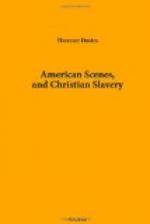I should draw too largely upon your patience, were I to describe many objects of interest and many scenes of beauty I witnessed in New York and the neighbourhood. The Common Schools; the Croton Waterworks, capable of yielding an adequate supply for a million-and-a-half of people; Hoboken, with its sibyl’s cave and elysian fields; the spot on which General Hamilton fell in a duel; the Battery and Castle Garden—a covered amphitheatre capable of accommodating 10,000 people; the Park, and the City Hall with its white marble front; Trinity Church; and its wealthy Corporation; Long Island, or Brooklyn, with its delightful cemetery, &c., &c. Suffice it to say that New York has a population of about 400,000; and that it has for that population, without an Established Church, 215 places of worship. Brooklyn has also a population of 60,000, and 30 places of worship.
LETTER XXXVI.
The May Meetings—Dr. Bushnell’s Striking Sermon—Two Anti-Slavery Meetings—A Black Demosthenes—Foreign Evangelical Society—A New Thing in the New World—The Home-Missionary Society—Progress and Prospects of the West—Church of Rome—Departure from New York—What the Author thinks of the Americans.
The American May Meetings held in New York do not last a month as in England,—a week suffices. That week is the second in the month. On the Sabbath preceding, sermons on behalf of many of the societies are preached in various churches. On the morning of the Sabbath in question we went to the Tabernacle, not knowing whom we should hear. To our surprise and pleasure, my friend Dr. Baird was the preacher. His text was, “Let thy kingdom come;” and the object for which he had to plead was the Foreign Evangelical Society, of which he was the Secretary. His sermon was exceedingly simple, and the delivery quite in an off-hand conversational style. There was no reading.
In the evening we heard Dr. Bushnell preach, on behalf of the American Home-Missionary Society, at the “Church of the Pilgrims” in Brooklyn. This is a fine costly building, named in honour of the Pilgrim Fathers, and having a fragment of the Plymouth Rock imbedded in the wall. The sermon was a very ingenious one on Judges xvii. 13: “Then said Micah, Now know I that the Lord will do me good, seeing I have a Levite to my priest.” The preacher observed that Micah lived in the time of the Judges—what might be called the “emigrant age” of Israel,—that he was introduced on the stage of history as a thief,—that he afterwards became in his own way a saint, and must have a priest. First, he consecrates his own son; but his son not being a Levite, it was difficult for so pious a man to be satisfied. Fortunately a young Levite—a strolling mendicant probably—comes that way; and he promptly engages the youth to remain and act the padre for him, saying, “Dwell with me, and be a father unto me.” Having thus got up a religion, the thief is content,




